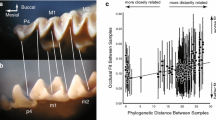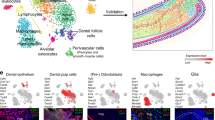Abstract
Early in the twentieth century, biology was seen as grounded in the dual foundations of cells and evolution. Cells provided the most basic living unit, and evolution provided a way for cells to become established in different organisms. However, as the twentieth century progressed, cells and cellular level phenomena became embedded in different research traditions within developmental biology with varying connections to an evolutionary framework. While researchers focusing on differentiation could continue to link their research to evolution through heredity, those focused on morphogenesis largely gave up any evolutionary perspective. Morphogenetic research programs continued, without evolution, until late into the twentieth century, when fruitful new insights brought development back into the process of evolution. This chapter takes teeth as an exemplary case study for these changes with special focus on the enamel knot, now thought of as the morphogenetic control center of the developing tooth. Once development, and especially cellular level phenomena, was seen in the light of evolution, the enamel knot became the central component of a new paradigm in evolutionary developmental biology—one that, to this day, continues to provide a means of understanding the development and evolution of teeth. The intersection of cells and “the Darwinian tradition” is a complex relationship. This chapter offers an alternative history of the ways in which development, evolution, and cells were brought together throughout the twentieth century and challenges the common conception that genes are the sole locus of explanation for research at the intersection of development and evolution.
Similar content being viewed by others
References
Ahrens H (1913) Die Entwickelung der menschlichen Zähne. Anatomische Hefte 48:167–266
Allen G (1975) Life science in the twentieth century. Wiley, New York
Allen G (1979) Thomas Hunt Morgan. The man and his science. Princeton University Press, Princeton
Born G (1883) Die Plattenmodellimethode. Arch Mikrosk Anat 22:584–599
Butler P (1956) The ontogeny of molar pattern. Biol Rev Camb Philos Soc 31:30–69
Cain J (2009) Rethinking the synthesis period in evolutionary studies. J Hist Biol 42:621–648
Cain J, Ruse M (2009) Descended from Darwin. Insights into the history of evolutionary studies, 199–1970. American Philosophical Society, Philadelphia
Churchill F (2015) August Weismann. Development, heredity, evolution. Harvard University Press, Cambridge
Delisle R (2009) The uncertain foundation of neo-Darwinism: metaphysical and epistemological pluralism in the evolutionary synthesis. Stud Hist Philos Biol Biomed Sci 40:119–132
Delisle R (2011) What was really synthesized during the evolutionary synthesis? A historiographic proposal. Stud Hist Philos Biol Biomed Sci 42:50–59
Delisle RG (2017) From Charles Darwin to the evolutionary synthesis: weak and diffused connections only. In: Delisle RG (ed) The Darwinian tradition in context: research programs in evolutionary biology. Springer, Cham, pp 133–168
Depew DJ (2017) Darwinism in the 20th century: productive encounters with saltation, acquired characteristics, and development. In: Delisle RG (ed) The Darwinian tradition in context: research programs in evolutionary biology. Springer, Cham, pp 61–88
Gudipaty S, Lindblom J, Loftus P, Redd M, Edes K, Davey C, Krishnegowda V, Rosenblatt J (2017) Mechanical stretch triggers rapid epithelial cell division through Piezo1. Nature 543:118–121
Hopwood N (1999) Giving body’ to embryos: modeling, mechanism, and the microtome in late 19th-century anatomy. Isis 90:462–496
Hopwood N (2002) Embryos in wax: models from the Ziegler Studio. Whipple Museum of the History of Science, Cambridge
Hopwood N (2015) Haeckel’s embryos. Images, evolution, and fraud. University of Chicago Press, Chicago
Huxley J (1927) The stream of life. Harper and Brothers, New York
Huxley J (1943) Evolution. The modern synthesis. Harper and Brothers, New York
Jernvall J (1995) Mammalian molar cusp patterns: developmental mechanisms of diversity. Acta Zool Fenn 198:1–61
Jernvall J (2000) Linking development with generation of novelty in mammalian teeth. Proc Natl Acad Sci 97:2641–2645
Jernvall J, Kettunen P, Karavanova I, Lawrence M, Thesleff I (1994) Evidence for the role of the enamel knot as a control center in mammalian tooth cusp formation: non-dividing cells express growth stimulating Fgf-4 gene. Int J Dev Biol 38:463–469
Jernvall J, Åberg Y, Kettunen P, Keränen S, Thesleff I (1998) The life history of an embryonic signaling center: BMP-4 induces p21 and is associated with apoptosis in the mouse tooth enamel knot. Development 125:161–169
Jernvall J, Keränen S, Thesleff I (2000) Evolutionary modification of development in mammalian teeth: quantifying gene expression patterns and topography. Proc Natl Acad Sci 97:14444–14448
Keränen S, Åberg T, Kettunen P, Thesleff I, Jernvall J (1998) Association of developmental regulatory genes with the development of different molar tooth shapes in two species of rodents. Dev Genes Evol 208:477–486
Keränen S, Kettunen P, Åberg T, Thesleff I, Jernvall J (1999) Gene expression patterns associated with suppression of odontogenesis in mouse and vole diastema regions. Dev Genes Evol 209:495–506
Kirino T, Nozue T, Inoue M (1973) Deficiency of enamel knot in experimental morphology. Okajimas Folia Anat Jpn 50:117–131
Koopman P (2001) In situ hybridization to mRNA: from black art to guiding light. Int J Dev Biol 45:619–622
Laubichler M, Maienschein J (2007) From embryology to evo-devo: a history of developmental evolution. MIT Press, Boston
MacCord K (2017) Development, evolution, and teeth: how we came to explain the morphological evolution of the mammalian dentition. PhD dissertation at Arizona State University
MacCord K, Maienschein J (2017) The historiography of embryology and developmental biology. In: Dietrich M, Borrello M, Harman O (eds) Historiography of biology. Springer, New York
Maienschein J, Laubichler M (2014) Exploring development and evolution on the tangled bank. In: Thompson P, Walsh D (eds) Evolutionary biology: conceptual, ethical, and religious issues. Cambridge University Press, Cambridge, pp 151–171
Mayr E (1982) The growth of biological thought. Diversity, evolution, and inheritance. Harvard University Press, Cambridge
Newman S, Forgacs G, Müller G (2006) Before programs: the physical origination of multicellular forms. Int J Dev Biol 50:289–299
Niswander L, Martin G (1992) Fgf-4 expression during gastrulation, myogenesis, limb and tooth development in the mouse. Development 114:755–768
Nozue T (1971a) Chronological study of enamel knot with special reference to mitoses in enamel knot. Okajimas Folia Anat Jpn 48:1–13
Nozue T (1971b) Specific spindle cells and globular substances in enamel knot. Okajimas Folia Anat Jpn 48:139–151
Pigliucci M (2017) Darwinism after the modern synthesis. In: Delisle RG (ed) The Darwinian tradition in context: research programs in evolutionary biology. Springer, Cham, pp 89–104
Pispa J, Jung H, Jernvall J, Kettunen P, Mustonen T, Tabata M, Kere J, Thesleff I (1999) Cusp patterning defect in Tabby mouse teeth and its partial rescue by FGF. Dev Biol 216:521–534
Radlanski R (1995) Morphogenesis of human tooth primordia: the importance of 3D computer-assisted reconstruction. Int J Dev Biol 39:249–256
Reichenbach E (1926) Die Umwandlung der Schmelzpulpa und der Schmelzepithelien während der Entwicklung des Zahnes. I Untersuchungsmethoden und eigene Befunde. Z ges Anat I Z Anat EntwGesch 80:524–546
Reichenbach E (1928) Die Umwandlungen der Schmelzpulpa und der Schmelzepithelien während der Entwicklung des Zahnes. II und III. Z Anat Entwicklungsgesch 85:490–540
Richards R (2008) The tragic sense of life. Ernst Haeckel and the struggle over evolutionary thought. University of Chicago Press, Chicago
Smocovitis B (1996) Unifying biology: the evolutionary synthesis and evolutionary biology. Princeton University Press, Princeton
Tanimura T (1968) Effects of mitomycin C administered at various stages of pregnancy upon mouse fetuses. Okajimas Folia Anat Jpn 44:337–355
Thompson D (1917) On growth and form. Cambridge University Press, Cambridge
Vaahtokari A, Åberg T, Jernvall J, Keränen S, Thesleff I (1996) The enamel knot as a signaling center in the developing mouse tooth. Mech Dev 54:39–43
Wolpert L (1994) Do we understand development? Science 266:571–572
Author information
Authors and Affiliations
Corresponding author
Editor information
Editors and Affiliations
Rights and permissions
Copyright information
© 2017 Springer International Publishing AG
About this chapter
Cite this chapter
MacCord, K., Maienschein, J. (2017). Cells, Development, and Evolution: Teeth Studies at the Intersection of Fields. In: Delisle, R. (eds) The Darwinian Tradition in Context. Springer, Cham. https://doi.org/10.1007/978-3-319-69123-7_13
Download citation
DOI: https://doi.org/10.1007/978-3-319-69123-7_13
Published:
Publisher Name: Springer, Cham
Print ISBN: 978-3-319-69121-3
Online ISBN: 978-3-319-69123-7
eBook Packages: Biomedical and Life SciencesBiomedical and Life Sciences (R0)




